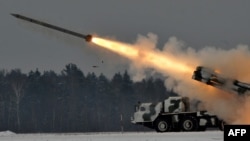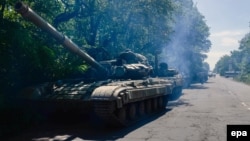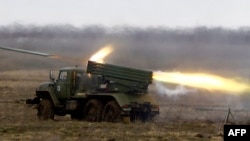Just a few short months ago, separatist sentiment in eastern Ukraine was underscored by fisticuffs and the occasional appearance of small arms. As unrest rose, Kalashnikovs and Molotov cocktails entered the scene.
And in recent weeks, the separatists have deployed much more sophisticated weapons in their fight against Ukrainian forces amid rising accusations that Russia is the supplier.
APCs
Armored personnel carriers (APCs) first came into the control of separatists in April. This YouTube video shows Ukrainian troops peacefully abandoning their vehicles to rebels in the town of Kramatorsk, in eastern Ukraine.
T-64 Tanks
The U.S. State Department said in early June that Russia had sent tanks to separatists in Ukraine. It said NATO satellite photographs showed that three T-64 tanks crossed the border near the Ukrainian town of Snizhne.
The T-64 has been phased out of service in the Russian Army, though they are believed to be stored in southwest Russia. The Ukrainian Army's arsenal includes T-64s, leaving open the possibility that separatists could commandeer them.
On June 30, the Ukrainian Army said it had captured a T-64 tank near Artemivsk, in the Donetsk region, it claimed was from Russian military stocks.
Portable Air-Defense Systems (MANPADS)
The rebels have used shoulder-held Man Portable Air-Defense Systems (MANPADS) since June, when they began using them to shoot down Ukrainian military aircraft.
According to one report, rebels have downed at least 10 aircraft, including five Mi-24 Hinds, two Mi-8 helicopters, one An-2, one An-30, and a Ukrainian transport plane. Pro-Russian rebels claimed responsibility for shooting down two additional Ukrainian Su-25 fighters on July 16.
The deadliest attack on record came on June 14, when pro-Russia separatists shot down a Ukrainian military transport plane, killing all 49 crew and troops aboard.
Many of the aircraft are believed to have been downed by MANPADS, although they could also have been taken out by larger and more sophisticated systems like the Buk surface-to-air missile system (see below).
Grad Rocket Launchers
The BM-21 Grad is a Soviet-designed, truck-mounted multiple rocket launcher. It is capable of firing unguided rockets with a range of 20-45 kilometers, depending on the rockets used. Both the Ukrainian and Russian militaries use Grads.
Pro-Russian separatists on July 11 launched a volley of Russian-made Grad missiles on the border post at Zelenopillya, in Ukraine's Luhansk region, killing 23 servicemen and wounding nearly 100 others.
Since then there have been a number of reports of Grad rocket launchers being used by rebels in the Luhansk and Donetsk regions, which lie on Ukraine's eastern border with Russia.
Tornado Rocket Launcher
Aside from the Grad, there have been reports that a much more modern rocket-launching systems have entered the theater, the Tornado. The system, which was adopted by the Russian armed forces in 2010, has been described by one defense analyst as a "new developmental multiple-launch rocket system and artillery-support weapon." Its range is greater than that of a Grad system.
Infographic: Map Of Recent Aircraft Incidents In Eastern Ukraine
Ukrainian authorities claimed that the Tornado system was used to launch an attack on Ukrainian forces from Russia on June 13. The attack in Zelenopillya, near the Russian border, killed 19 Ukrainian soldiers, according to the Ukrainian military.
Buk Surface-To-Air Missiles
The Ukrainian Security Service (SBU) released an audio recording on July 18 in which purported separatists discuss receiving a Buk, along with a crew to operate it, from Russia.
Shortly before the Malaysia Airlines passenger jet was brought down on July 17, AP journalists reported seeing what appeared to be a Buk missile system near the rebel-held eastern town of Snizhne.
The Buk is a 1970s-era, truck-mounted, radar-guided missile system. It fires a 5.7-meter, 55-kilogram missile to an altitude of around 25,000 meters. It remains widely in use in the former Soviet republics, including in Ukraine.
On June 29, Russia's official news agency, ITAR-TASS, reported that rebels took a Buk system under their control. The report does not specify whether the system was obtained from the Russian or Ukrainian militaries, only that the rebels had seized control of the weapons system.
The Buk is a sophisticated missile system that requires several trained operators. The system typically comprises four vehicles: a command post vehicle, a target-acquisition radar vehicle, the missile-launch vehicle (which has its own targeting radar), and a support vehicle.













